Whether you’ve just moved to a new horse property, or you want to fence a new section, or add some cross-fencing, or you’ve got challenging terrain to fence – we’ve got you covered! I’ve gathered together some of the best fencing ideas for you to peruse, along with my personal opinion on barbed wire and Bayco elastic fencing.
First of all, I watched an excellent presentation by an experienced Veterinarian, Dr. Geoff Tucker, who’s been to many different farms and barns. Geoff has then collected photos of some of the do’s and don’ts we can apply to our properties, barns and fencing. In this post, I’m going to focus on the fencing options as this is something I’ve been experimenting with lately.
If you want the full barn safety info (and it’s excellent – based on decades of experience with thousands of clients), then start watching Geoff’s video here at 5 minutes (the beginning is just intro).
For now, I’m going to show you some of the best fencing options that I screenshot from this video:
1. Board Fence Done Right!
In this photo you can see the boards are on the inside of the fence posts – keeping a smooth surface against the horse (prevents them banging/hooking a shoulder on a post). This also makes the fence stronger as the board will not pop out when a horse leans or rubs hard on it. Note the bottom board is far enough from the ground that if a horse lays down next to the fence, their legs will not get stuck when they try to get up.
However, as Dr. Tucker points out, this distance is too high to be safe for a foal, who could roll under and get up on the other side of the fence – separated from mum! Also note the buffer alley in between paddocks (handy for manure and hay carts too!). A lot of fence damage is done by horses trying to get at each other – for reasons of play, aggression, or in heat.
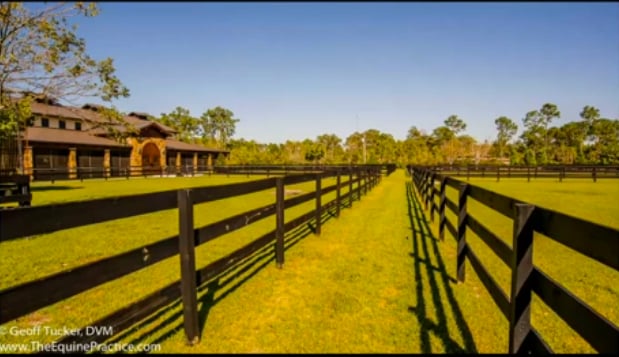
2. Diamond Mesh with Boards
Dr. Tucker says this diamond mesh is very tough and he’s never seen a horse that can break through it, nor has he ever seen one caught up in it. Note the boards are on the inside of the fence posts – keeping a smooth surface against the horse (prevents them damaging a shoulder on a post). This also makes the fence stronger as the board will not pop off when a horse leans or rubs hard on it. Likewise, the diamond mesh is also afixed to the inside of the fence.
This is Dr. Tucker’s favorite fence and was used for Secretariat. He also points out that the corners are rounded off (no square corners) so a horse can’t get trapped there by another horse. The corners have 3 boards, but the straight sections only require a single board at the top. Not only does this improve the strength of the fence, it also takes care of the visibility issue (wire fences are hard to see in certain light conditions or when the horse is in a panic).
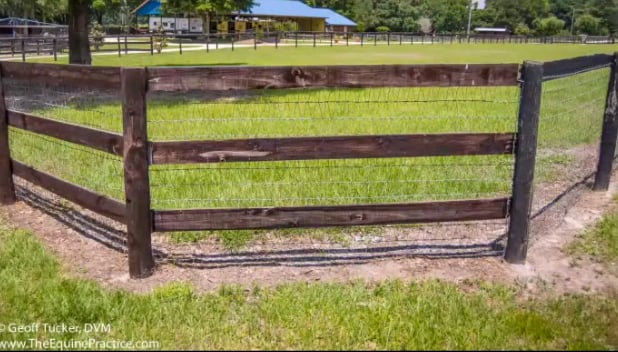
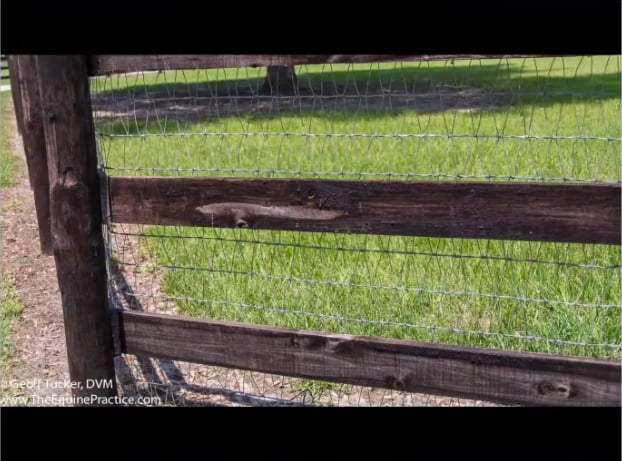
3. Vinyl Fence with Electric Wires
Here’s a vinyl fence with electric wires running along the inside of the boards. Dr. Tucker likes this fence because if the horse runs into it, he’s just going to bounce off. Again, boards should always be on the inside of fence posts, so horses can’t pop the boards off easily.
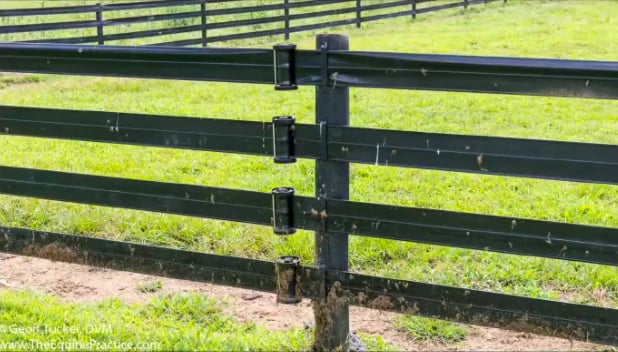
4. Pipe Fencing
Another fencing option that Dr. Tucker likes is welded metal pipe fencing – a cheaper option if you live in an area with an oil/gas industry that generates cheap surplus pipe. If you don’t, and you have to buy steel railings or posts from a fence company, then it is a very expensive fencing option.

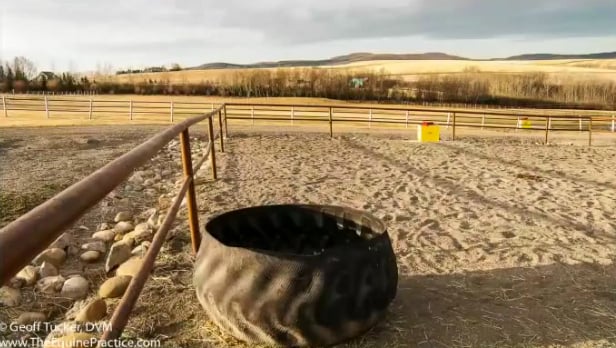
Barbed Wire vs. High Tensile Steel Wire
Now let’s get into a thorny issue. We all know that barbed wire is not a good fencing option for horses. However, some people have a line of barbed wire fencing because they share a field with cows. Or, they are boarding their horses on someone else’s property.
I recently read a great article on barbed wire and the Comments underneath the post are as good as the article – especially the one where a horse ran into the wood fence on one side, then into the barb wire fence on the other… (spoiler alert: The wood did more damage). So if you currently have some barbed wire fencing, take some time to read through this article and the comments. I’m not going to repeat anything here, because it’s just that good!
I will say that I had 3 horses and 2 foals in a well-maintained (no loose wires) barbed wire field for 10 years in Alberta and not one of them sustained an injury. In my current place (I’m boarding) there was a mix of barbed wire, high tensile steel wire, and board fence. The only injury incurred in the last six years was with the smooth steel wire; which my then 2-year-old colt (Montaro) used to slice off the back of his heel (it has a 3,000 lb break weight) requiring surgery and a $450 vet bill.
Ironically, we used the smooth steel wire in that spot to keep them away from the rotting wood fence, as the tenant didn’t want barbed wire used on that fence line. Personally, I think that if the wire had been barbed, Montaro would not have stuck his foot through. All the horses figured out pretty quickly that barbed wire hurts and they stay away from it for anything vigorous. For minor activities, like leaning against it, they don’t care:
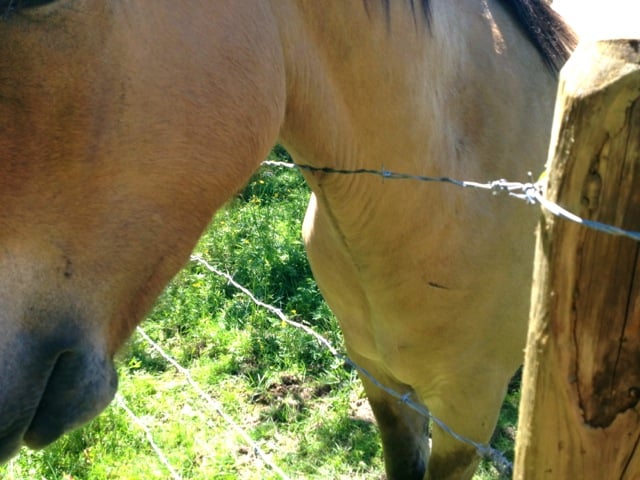
My semi-feral and wild horses go right through blackberry bushes too! I routinely check their faces for embedded blackberry barbs and pull them out. And the younger horses have minor rips all over the place (they also spar quite a bit). My domestic horse won’t touch barbed wire or blackberry bushes.
I also used the high tensile smooth steel wire in a corner of the paddock area, since I’d heard it was a good alternative to barbed wire. Again, if you’re boarding on someone else’s property, or money is really tight, you can’t always implement the ideal. Having had no experience with smooth steel wire, I thought I’d test it:
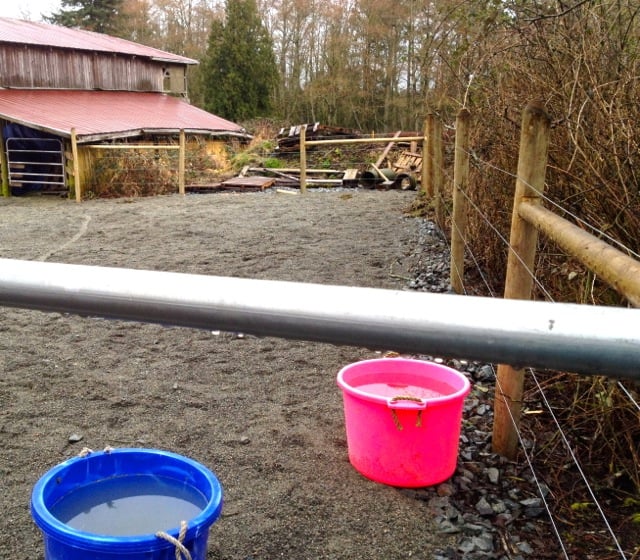
After observing the horses for several months, I would not use this kind of fencing again! I’m not saying that barbed wire is necessarily better, but at least they realize barb wire hurts and stay away from it. With this smooth steel wire, they play with it! Having no idea that it can slice through flesh; they rub on it with their head and necks, they stomp on it with their feet, they push against it. Apparently vets have seen many serious injuries from high tensile steel wire.
And if the horse happens to run into it, this wire is not going to break – it’s just going to slice through the horse’s flesh. Here’s what happened in a wind storm when a few trees fell on it. The wire loosened (even more fun to play with!) but did not break:
I have since also covered over this steel wire with a length of mesh fence. Yes, it’s more expensive, but cheaper than another vet bill or two!
However, the main problem with any kind of single-strand wire fence is not what the horse does when they’re conscious, but what they do when they are being chased by coyotes, or in a fight, or otherwise frightened. As Dr. Geoff Tucker says:
“The reason we use cowhides, is because it’s tough. I’ve seen cows go right through barbed wire, leaving [only] little tufts of hair, and the wire is in shambles. But as soon as the horse goes through barbed wire, it’s a meat cutter and it’s no good, and it should be outlawed for every horse.”
So on the high tensile steel fence line where my colt sliced his foot, I put up 2×4 inch wire mesh, on the pasture side, covering up the steel wire and the wooden fence. They lean right over the top of it to get to the grass lawn on the other side, but so far it is holding up well and no injuries! The wooden posts on this line are sunk into concrete – otherwise, they would no doubt just push the whole fence over. I didn’t know about diamond mesh when I used this 2×4″ mesh, otherwise I would have used that instead. This size mesh is fine for adult horses, but a young foal could get a hoof stuck in this:
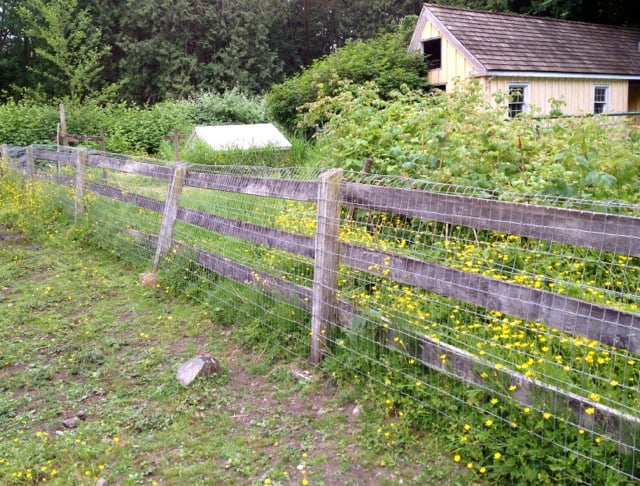
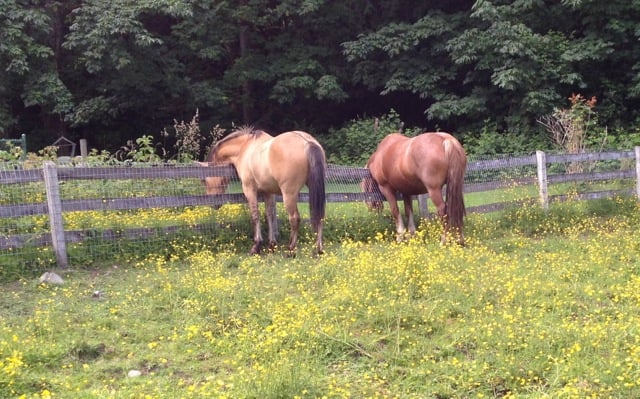
And here’s another consideration for those of us in wet, rainy climates. Even if you use treated posts, your fence posts (and boards) can rot in 15-20 years and need to be replaced. The only type of fence you could use in this climate that would never have to be re-done is steel posts, sunk in concrete. However, treated wood posts sunk in concrete with a combination board (even just 1 board) and diamond mesh fence should last at least 30 years.
If you already have barbed wire, or high tensile steel wire up, you could even just place the diamond mesh over top of the existing wire. If you don’t have cows to contend with on the other side though, then you may want to remove the barbed wire, to prevent your horses getting little tears from it.
New Option: Elastic Fencing!
Now, having said all of the above, I attended a workshop with trainer/filmmaker Elsa Sinclair and she told me about an intriguing new elastic fencing option called Finishline Fencing. This fencing material is produced by a company called Bayco. So you may also see if advertised as Bayco elastic fencing. Although these stretchy strands have a break-weight of 1200 lbs, they are also designed to stretch/give 20%. So even foals who have gone completely through the fencing are unharmed and just come back in through the strands which stretch out of the way!
I figured this fencing would be great for me to use in the wooded areas of my pasture, where trees and branches fall on the fence all the time; either taking out the fence line, or making the use of electric wire impossible. Here’s the picture that convinced me this elastic fence could actually work in my forested areas:
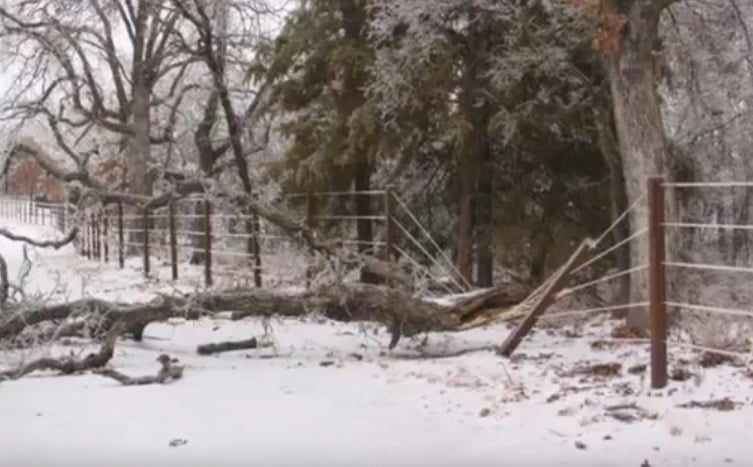
So four years ago, I decided to fence about 10 acres at the back using this new elastic fenceline material. Since this area is densely forested and home to lots of wildlife, I decided to see if an ‘organic’ curvy fenceline would work; rather than just straight lines, which would require a lot of tree-cutting.

Let me show you the challenges that resulted from both using this elastic wire/line and not having poker straight fencelines!
1. Brace against tension
When you have a curvy fenceline, and then you tighten up the lines on it, the tension is not even. This sounds obvious, I know, but we thought we could counter the pull by moving the line to the other side of the posts where needed, to offset the tension. Nope. Maybe if you lived in a dry climate and your ground was rock hard for your posts, that might work. But in our rainy Pacific Northwest/UK type climate, our posts just could not withstand the torque. So we had to add bracing at all vulnerable spots:
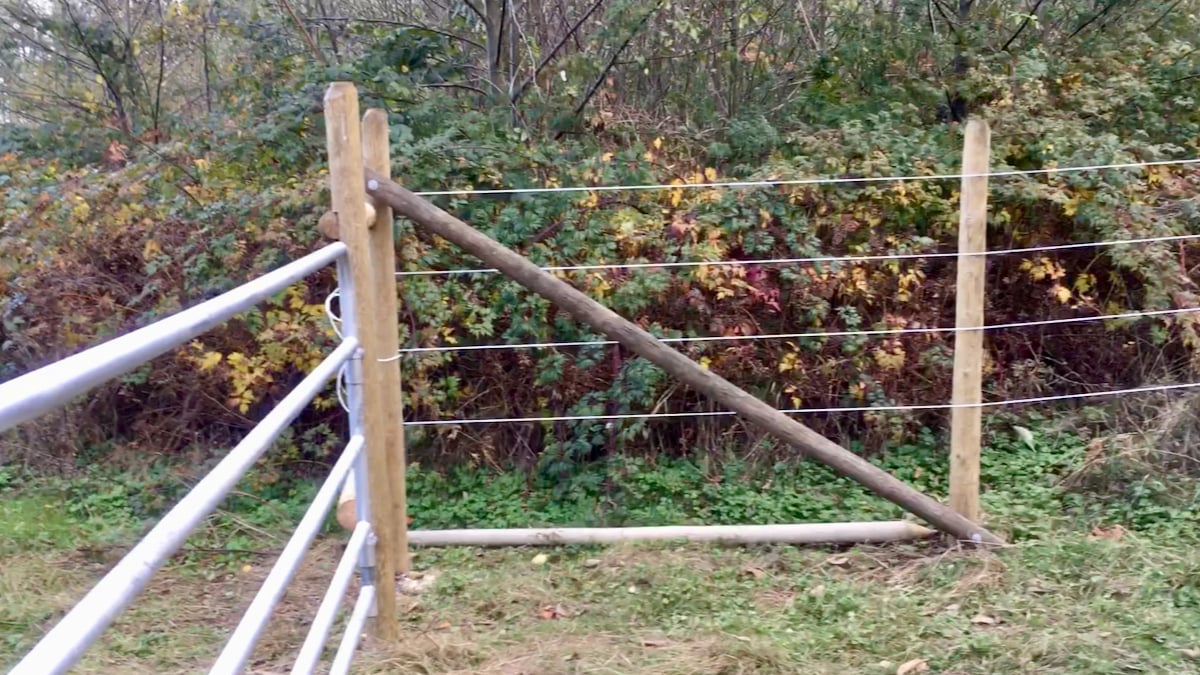
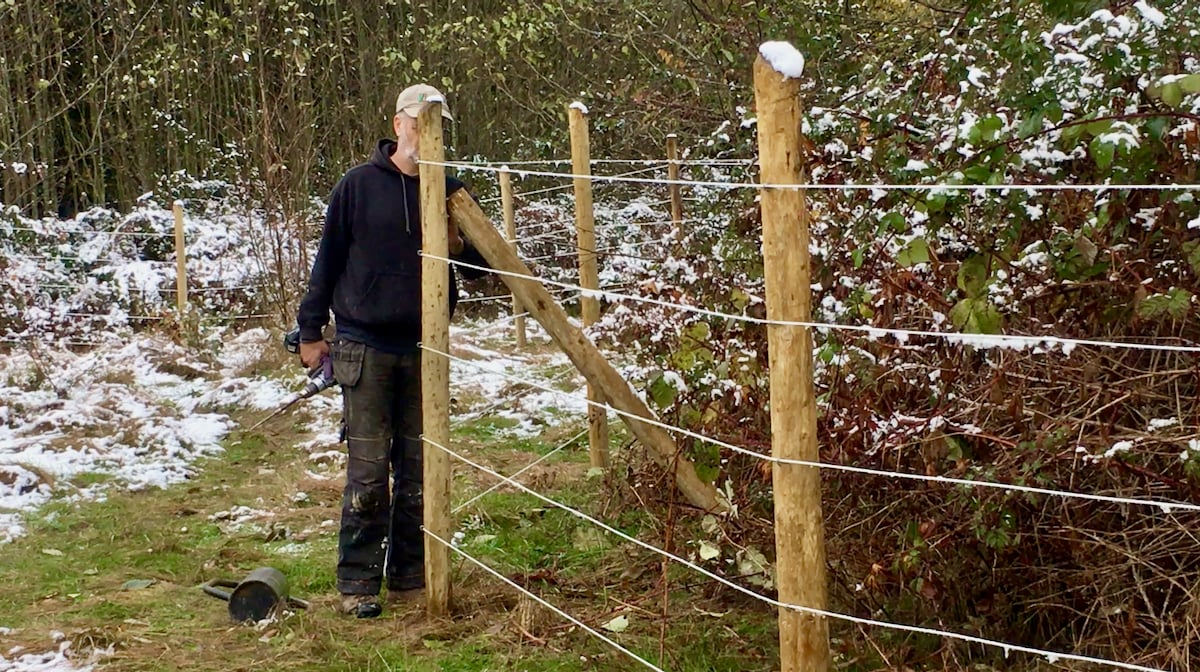
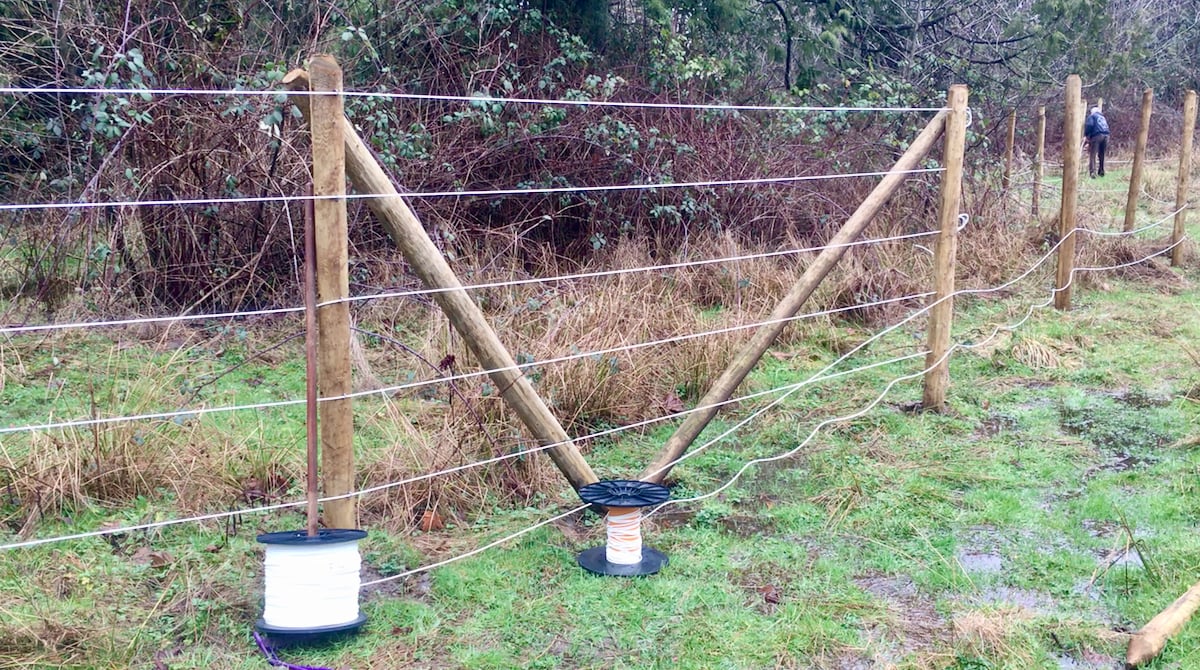
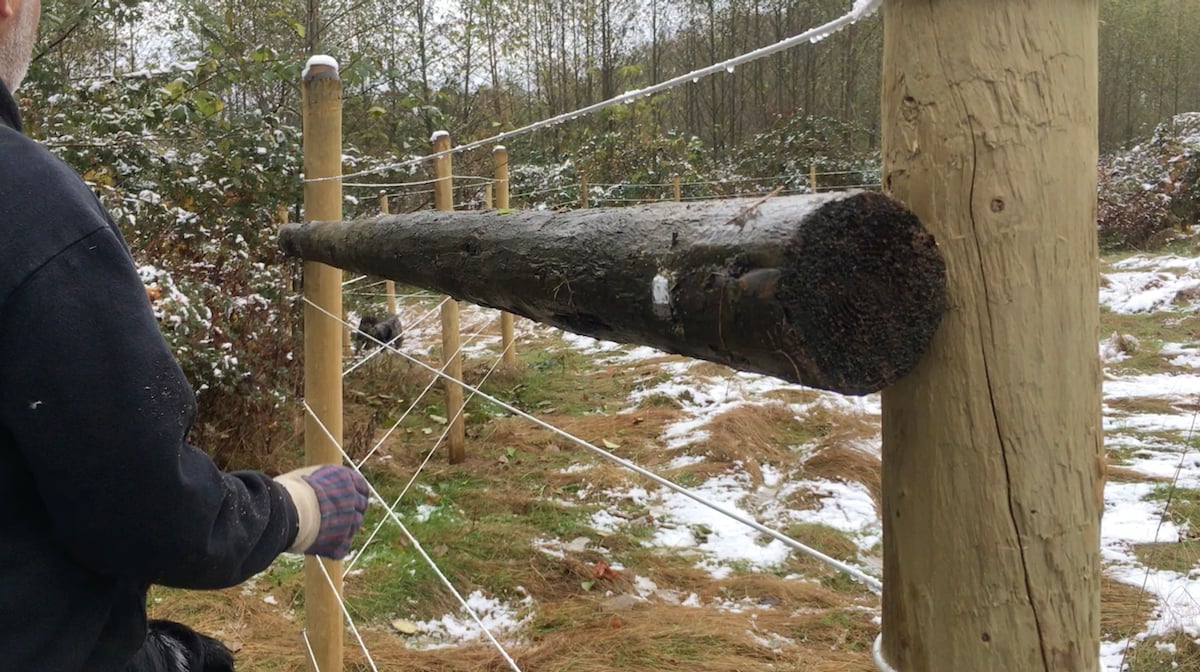
As you can see, we had to add a lot of bracing to make up for the all the points of torque threatening to pull the fence posts over. But due to the posts not being in a perfectly straight line, we also couldn’t tension up with lines the way you’re supposed to. Which created more issues…
2. Escape routes
Since we couldn’t fully tension up the lines, our lines were looser than recommended – which the horses quickly discovered. Montaro and Juno figured out how to go through the fence, graze or forage on the other side and then come back in whenever they pleased! Here’s one of the spots they favored. They would step on the lowest line to pin it to the ground, then use their neck to push up on the lines above – which would create a perfectly adequate gap to squeeze through.
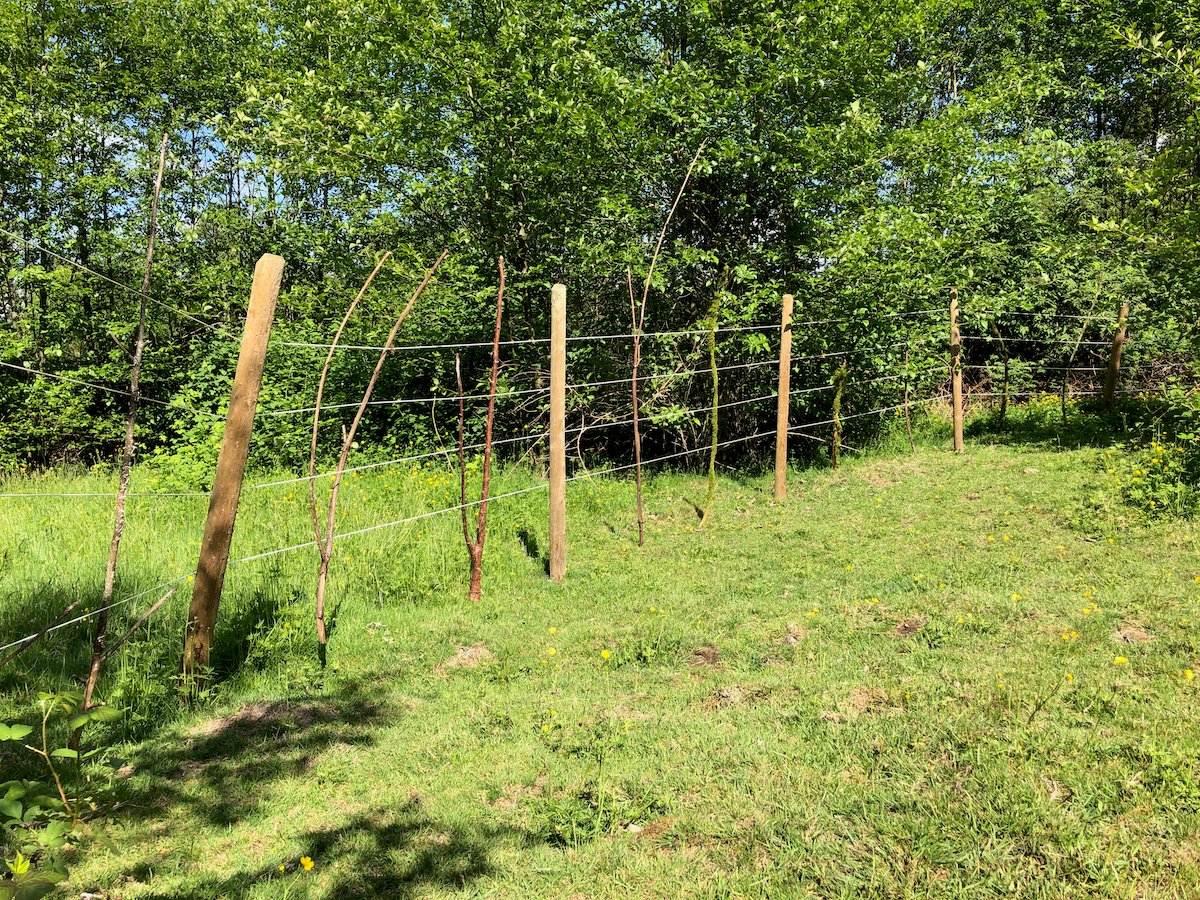
As you can see, we added branches to try and discourage them, but they just knocked the branches out the way. The only thing that worked was to add 2 lines of barbed wire along these sections.
You might be wondering why we didn’t just add more lines and space them closer together…? Well, we started out with 5 lines like this:
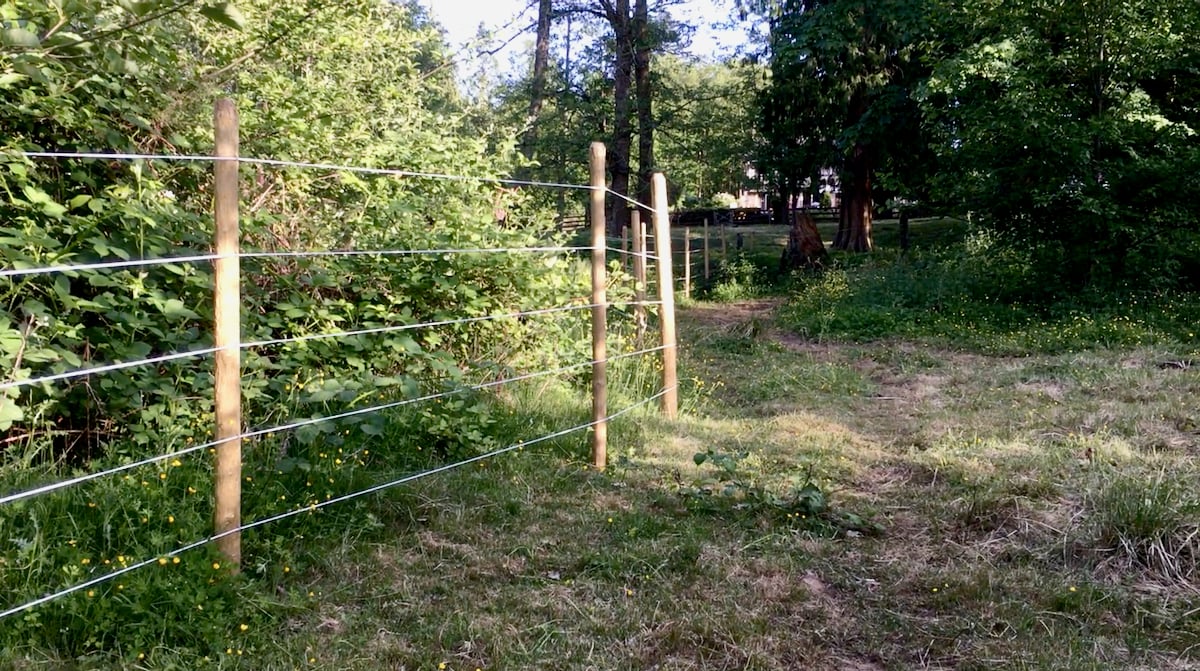
However, the deer did not like this arrangement! One day my dogs were chasing a deer and it fixed eyes on me as it scooched under the fence, staring at me as it popped up the other side, “You see?? We don’t have time to jump over the fence when coyotes are chasing us!”
Someone had been chewing through the bottom strand of the Bayco elastic fencelines at key points where there were wildlife trails – hence my bottom, 5th line had disappeared in numerous places. In one forested section of the pasture, they had chewed through the bottom 2 lines. This didn’t create a problem with the horses, since there was no inducement for them to leave the pasture at that section – all that was on the other side were trees.
So when I placed the strands of barb wire on the fenceline in the photo above, I placed them as high as I possibly could, to leave the deer and other animals as much clearance as I could. I had thought this fencing material would be ideal to leave passage open to wildlife. But as the deer showed me, during a high speed chase, they have to be able to get through the fencing in a split second.
3. Perfectly straight fencelines
Here’s the other issue that occurs when using this tensioned elastic fence line, that no amount of bracing can fix. If your posts are too far out of alignment at any spot, the tension in the lines simply pops your staples out of the posts:
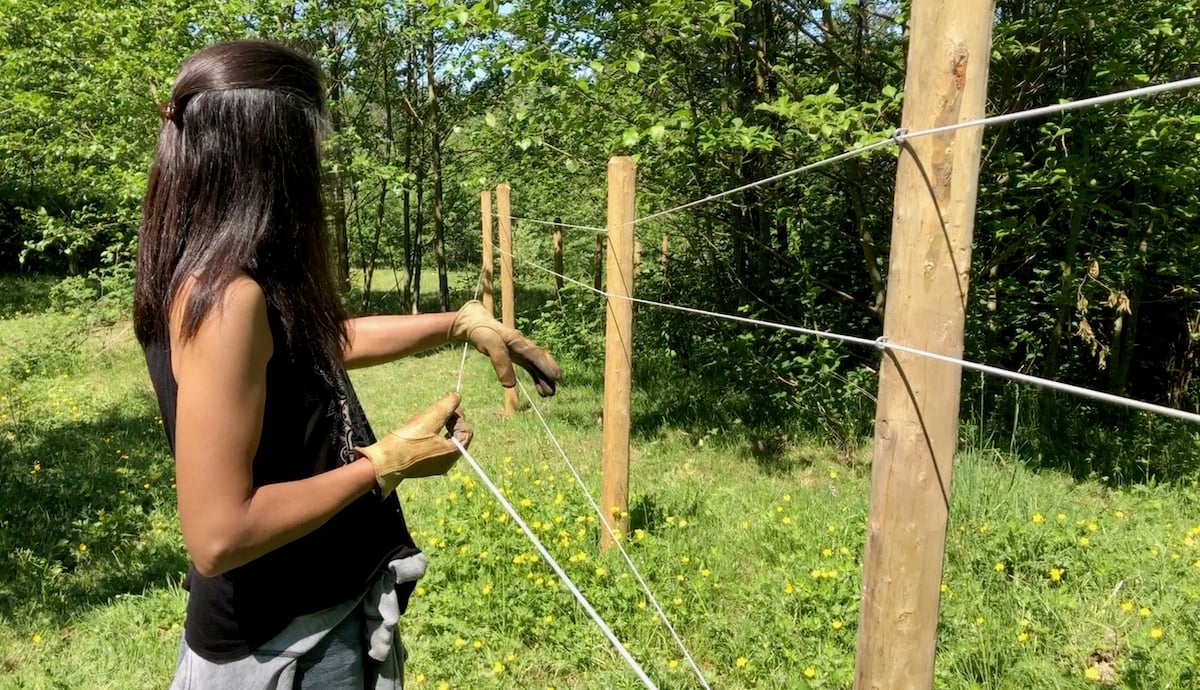
Not sure how this post got so far out of alignment with the others, but this is very rocky ground with buried boulders, so sometimes you just have to move the post to a new spot.
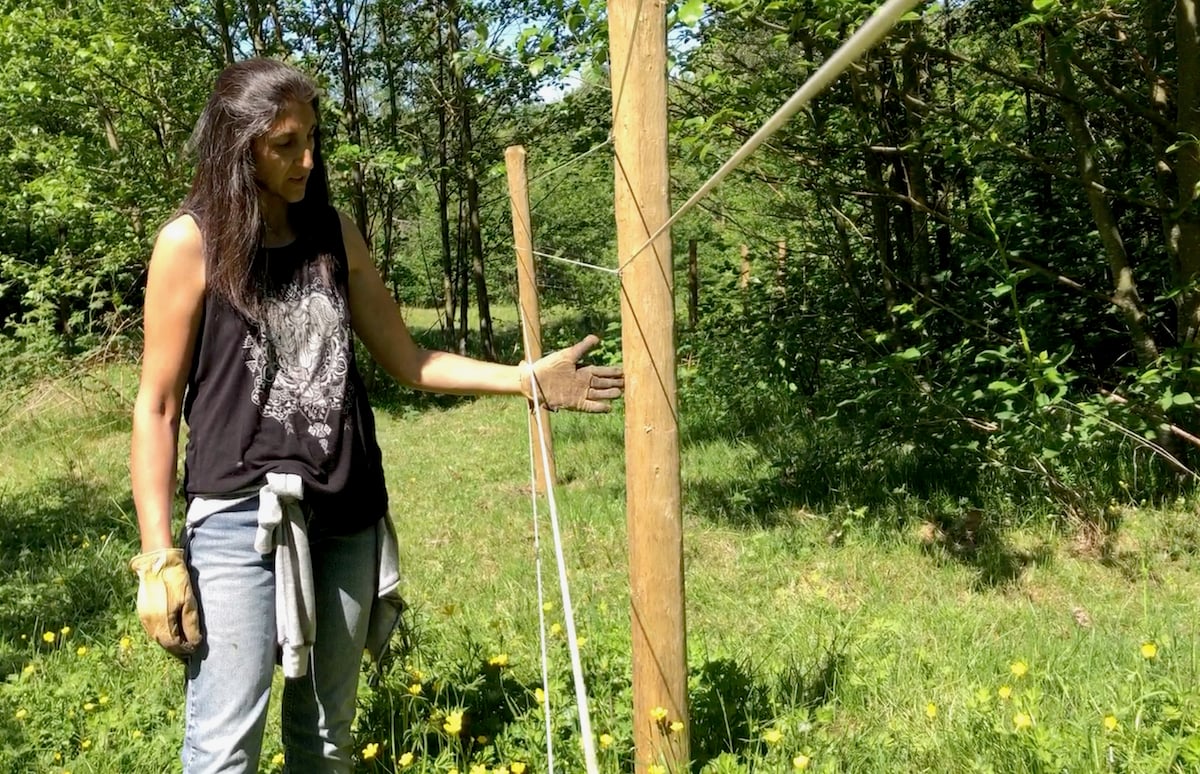
Then guess what the horses can do with a section of fence like this?
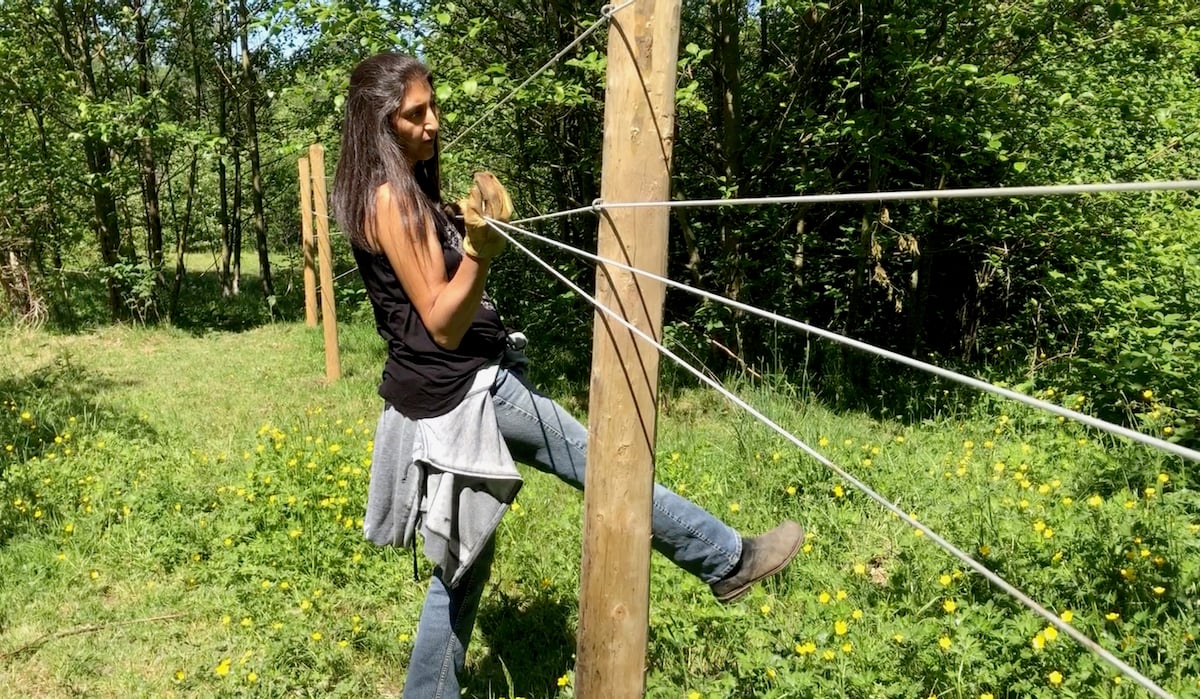
4. When a tree falls…
However, where this type of fencing is totally outstanding, is how it performs in heavily treed areas! This is where all that stretchy elastic really comes in handy:
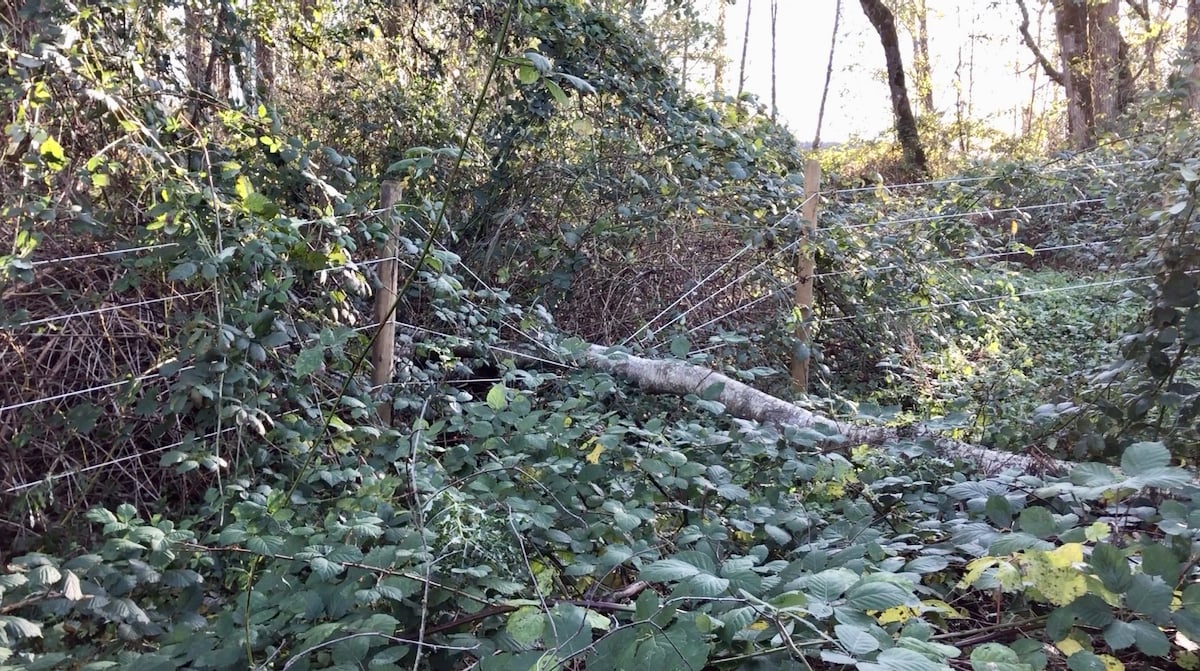
Once we removed the tree, we simply tightened up the lines again and voila! Fence was fixed in 5 minutes flat.
Oh and I have one last point to make – although this would apply to any kind of strand fencing – is to consider where your blackberries are. I was staring at this part of the fenceline, wondering why the blackberries had gone hogwild in this section… when I realized that by putting the elastic fenceline there, I had built them a trellis! What do we know from tomatoes and peas? Yep, if you give them a scaffold, their growth will increase greatly due to increased sun exposure.
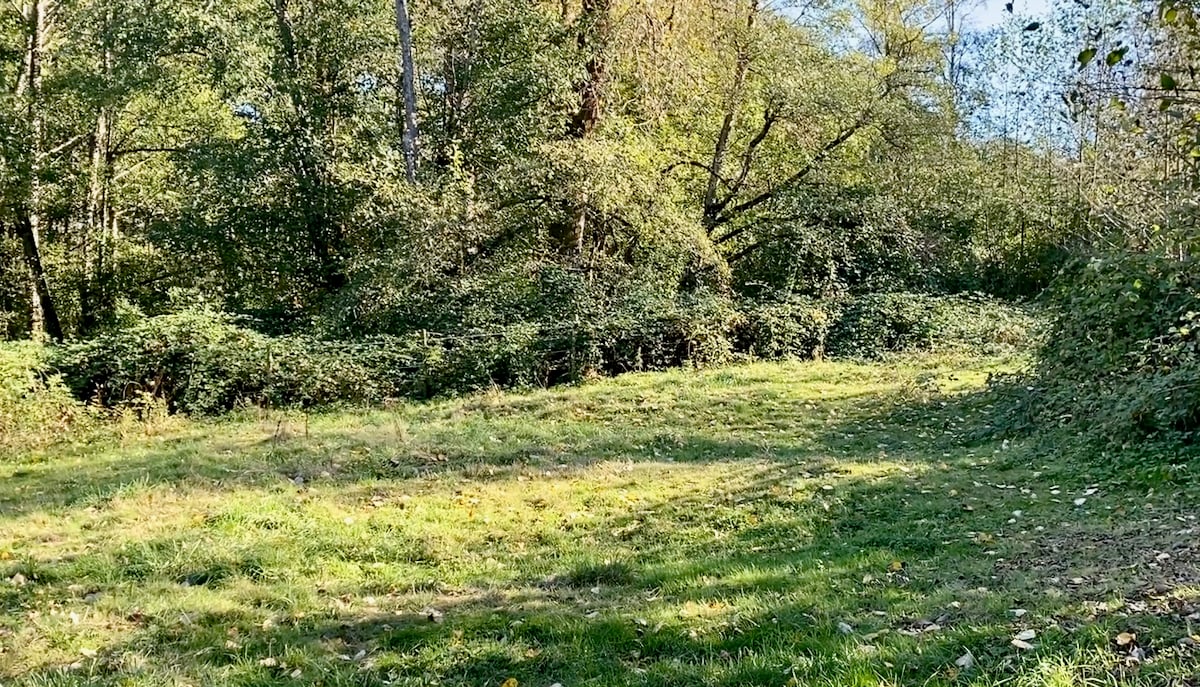
If I’d realized this, I wouldn’t have bothered hacking through the blackberries in this spot to place the posts here, I would have just moved the fenceline over. Or, known that I would have to be rigorous about keeping them cut back on a regular basis.
Would I use Bayco or Finishline Fencing again?
If I had domestic horses (with no escape artists in the bunch) and perfectly square or rectangular pastures, hard ground, and not much wildlife migration, then yes, this fencing is a good option. It is certainly way better for safety than high tensile steel wire. And for withstanding falling trees, you just can’t beat it!
I don’t like the fact that it is a plastic product – if I could ban plastics from the planet I would – so for me and my situation, there are not enough benefits to make up for the plastic pollution aspect.
I hope that round-up of fencing options has been helpful for you. I only use electric fencing when there’s no other option, or it’s only temporary, like when I’m regenerating pasture for a few months, so I haven’t gone into that option here. I don’t feel I have enough information on the effects of enclosed electrical loops on animals to make a choice about electric fencing as an option, or not. I don’t know how the currents travel through the air or through the ground. I do know (after having an engineer come and test my house) that it’s much healthier for me to unplug everything in my bedroom at night before sleep. But I haven’t seen any information on how electric fencing affects an animal’s electromagnetic field. If you know or have any links to data, please post them below!
Originally published May 2016, updated March 2021

Jini Patel Thompson is a natural health writer and Lazer Tapping instructor. She began riding at age 2 in Kenya, and got her first horse at age 8 in Alberta, and so continues a life-long journey and love affair with these amazing creatures.

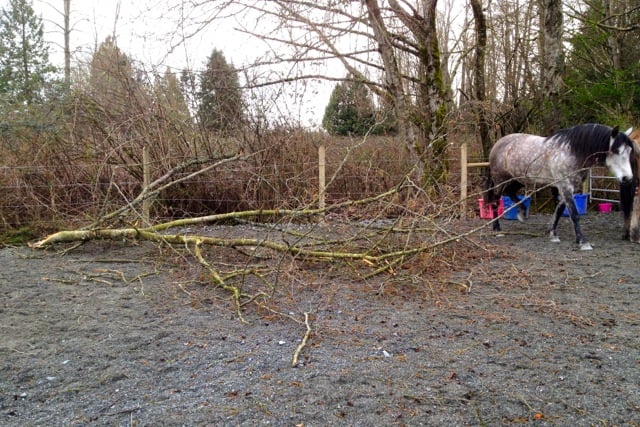







Interesting. I’m a great believer in safe fences. First, I like my horse to be safe from the fence. Then I like my fence to be safe from the horse. I believe that pretty much every fence should have either an offset hotwire at about horse-shoulder height, or a “safety fence” of a hotwire on fibreglass posts, or similar, set a couple of feet inside the other fence.
When I bought my place it had a brand new t-post and 5 strand barbed wire fence. I have an offset hotwire and have had no problems, except when someone turned horses out on the other side. A horse on my side kicked out at one on the other side and hung a back leg up. It was a spectacular accident, in which he finally flipped himself over the fence into the neighbour’s pasture, but he didn’t even need stitches. Now that side has a safety fence 2′ from the barbed wire fence. I can’t take any of my barbed wire down, as all my neighbours have cattle. I had never thought of covering the whole thing with mesh. What a great idea. (Unfortunately my fence is about 2 miles long, but I can dream!”)
That is unbelievable… trying to visualize that and ‘spectacular’ is a great word for it! Great ideas for both the offset and the inset electric safety fence – hadn’t thought of that one and yes, much cheaper than covering it up with mesh!
I like the idea of diamond mesh with boards. As you’ve said, it’s tough and sturdy. My father has been planning to built horse fencing on his small farm. He has 5 horses and he wants them to have a secured outdoor space. I’ll advise him to look for a reliable fence contractor in the area.
Elastic fencing is such a good idea! Looks like it really reduces a lot of potential damage
Well it certainly works for tree damage! Just updated this post with lots more info on the elastic fencing.
“..But I haven’t seen any information on how electric fencing affects an animal’s electromagnetic field. …”
I was asking myself that very question only last week!
xxxx
: )))
I use electric fencing with arabian horses. Its the only fencing i’ve used. They’re very chilled-out in their personalities, i think because i given them freedom, not locked in a stable for hrs on end, plenty of varied forage.
I would imagine a disturbed electromagnetic field of us or other mammal would have us feeling agitated and not ‘grounded’ – and considering the blood type of my horses often mistakenly being considered hot and crazy, they would show clearly if they’re not feeling settled…as theyre a very demonstrative breed.
My boyfriend has explained the technical aspects of electric fencing, as im not electrically-minded at all! So, the electricity from the charger/pulser unit positive terminal is sending a pulse along the metal strands in the fence wire. The negative wire is connected to the grounding rod at the charger unit. When a horse gets a zap anywhere along the fence line, because the horse is standing on the earth – and the earth is one united ‘ocean’ of electric, the zap travels through the horse, to the ground and back to the charger unit, completing the circuit – hence why they get zapped.
I’ve only had issues with them breaking out when the fence wasnt on/live. Due to low/dead battery mostly. My gelding is houdini when thats the case and will magically fly through 3 strands.
You must have the low ohm rope for horses – its more of a zap, can be tightened really well, and doesnt flap in the wind like the thin half inch white tape.
Once horses ‘test’ out the electric fencing and get a zap, its enough to warn them, they will avoid it from thereon. However! They are so clever and test if it is on/off with their muzzle whiskers…and if its off, some of them will just storm the fence, as its breaking strain is low (something i personally like about it)
Its tricky with foals. I was told to only make live the top 2 strands of a 4 strand electric fence setup by a breeder, for the foal. Unfortunately it turned out to be bad advice. The foal put his head between dead strand and live strand to graze the other side, and lifting his head up got zapped and completely freaked running away with the strands around his neck. I heard the dam calls and (just as it was getting dark of course) found the entire electric fencing tore up all over the place, broken plastic posts etc….wire draping across the field everywhere. Luckily he stopped when the resistance of the wire around his neck got so tight he couldnt move. All he sustained was a small cut on his neck where tape dug in. They trusted me to help them, stood calm and followed me to walk them out over lots of wires on the ground.
Had that been wire, barbed even, he wouldnt have even pulled it off the post to run from it. However, IF i had made live all 4 strands in the first place, the first moment the foal sniffed the fence to investigate it, he wouldve been zapped and would never had tried to poke his head between the strands to graze in the first place, which was the cause of the chaos.
That foal is the houdini gelding i mentioned! They learn to keep away from it when its on, but also learn its just rope when its off and easy to navigate through -so always keep it well charged, and learn from my mistakes of having a weak line or forgetting i turned it off. He’s never escaped or attempted to mess with it when its actually on – they will always do the whisker test.
Aside from that electric is great for really warning them/ and other stock to stay away from the fenceline. If theyre destroying your posts put just one line at the inside top of the posts. They won’t reach over to graze or use it to itch their butts and weaken posts.
I’ve anguished over fencing and costs for my large area. I’d prefer post and rail with one line of live rope at the top. Cost stops me right now. However, there is a good middle way. If you have posts set similar for post and rail, you then can buy very wide electrical tape that is tensioned onto the posts where rails normally go. Some choose 2 or 3 strands. Its about 3 inch wide tape thats very strong, tight and , if always electrically active, an excellent semi-permanent fencing, cheaper than post and rail. I’ll probably switch to that system when i can afford gazillions of posts!
Im not a fan of wire, smooth or barbed, mainly due to it not being visible, its meat-slicing ability. When a horse freaks they…well we all know – common sense goes out the window and hooves/legs seem to be everywhere. I prefer a breakable fence, but i am very rural and not next to a main road. Id prefer they escape uninjured than suffer horrendous injuries from wire.
I love the V shape mesh fencing jini highlighted. Its revolutionary, but pricey.
I’ll try to attach an image of a main field i change the grazing area with temporary electric fencing. Its looks so weak with the thin plastic posts, but its the electrical zap that is the strength to the weak-looking boundary. I prefer to have it stretched tight, but the tap and rope both are not ore-stretched so always stretch more after install and need re-tightening. I’ve been re-doing fencing this year and will take a pic and post it here how it best works. (Image attach not working, despite being jpg 350kb – will try a separate post)
Best wishes!
GREAT feedback and info Bec – thanks! You wouldn’t happen to have a meter that can measure electrical and magnetic fields would you? – see my reply to Ray…
I agree with you about foals and have had 2 foals (Juno and Xadaa) run through and completely destroy an electric fence – I would never rely on it as my only line of fencing with foals, or horses who don’t know what it is! Every time I’ve set up the electric fence (in Spring/Summer to let the grass rejuvenate) I’ve acted out (like charades) for the horses what will happen if I touch the fence. My acting job scares the crap out of most of them and to this day Aude won’t go within 10 feet of it and gets her worried eye wrinkle every time she looks at it. BUT those babies are just more curious and their fear/caution doesn’t last long – also dependent on personality of course as you’ve experienced!
I looked up the cost of the Diamond V mesh out of interest’s sake and yeah, pricey at $399 for 165 feet!
https://www.ruralking.com/red-brand-v-mesh-horse-fence-58-x165-roll-77856
Pays to shop around though as I found another place asking $578!
RE. your photo upload – check that your file name says .jpg NOT .jpeg It’s a weird thing but if it’s .jpeg it won’t upload.
Arrgh I KNEW this was going to happen and after reading your and Bec’s comments, of course I couldn’t NOT go look… just a peek, I told myself. Because I certainly don’t have the training to understand the tech operating here either…
Well after an hour or so, the only conclusion I have is that someone would have to use a Meter that can test for both electric and magnetic fields and see what the readings are. There simply isn’t enough/any information from unbiased sources. There is LOTS of info from electric fence manufacturers, hydro-electric companies, govt installation of high voltage power lines, etc. But in my brief foray I didn’t find much from any kind of independent, yet qualified source. Since I have that meter, perhaps I will do that when I electric-fence off the pasture in summer (to let the grass recover for a couple months)!
However, here is the info I compiled and WHY we’re going to have to test BOTH electric and magnetic fields. Also, check out the bit at the end from the Aussie forum – key points is that the amount of negative disturbance/effect of your electric fence is going to be directly related to how well grounded your fence is, and whether it is free from anything that interrupts the smooth flow of the current.
When looking at electric fencing, we need to look at both electrical activity and magnetic activity, because “electric and magnetic fields are generated by the presence of electricity. The intensity of the fields is high close to the source and usually decreases quickly with distance.”
The article [ http://www.hydroquebec.com/fields/pdf/pop_24_01.pdf ] goes on to say:
“The magnetic field (MF) is generated by electric current (measured in amperes), i.e. by the movement of the electrons. As a result, when a device is on, it creates a magnetic field. When it is turned off, it has no magnetic field. Unlike the electric field, there is no effective and inexpensive screen that can act as a shield against a magnetic field, which can easily cross through matter.
The electric field (EF) is associated with voltage. It is generated by the presence of electrical charges(electrons) and is measured in volts per metre (V/m). Near high-voltage lines, it is generally measured in kilovolts per metre (kV/m). The higher the voltage supplying the equipment, the stronger the electric field. A cable connected to a device that is plugged in generates an electric field even if the device is not turned on. The intensity of an electric field can be substantially reduced by the presence of objects acting as a shield: trees, fences, buildings, etc.”
Here’s some relevant info taken from an electric fence manufacturer:
“Amps are what kills. Voltage gets your attention – it hurts.
Electric fence energisers put out high voltage (around 8,000 volts) this makes a very clear mental imprint that really gets the attention of the target. However they also reduce the deadly amps to a very low amperage of around 120 milliamps (It varies with manufacturers). This is 120/Thousands of an Amp (normal home electricity is 13 Amps). It should not even kill a squirrel.
This output is made safe in two ways, firstly by releasing the flow of electrons from the capacitor in regular pulses of about 1/300th of a second approximately a second apart. The amperage component of the electrical charge is greatly reduced to figures in the range of 15 – 500 milliamps. (The majority of units operate in the 100-150 milliamp range).
Warning: In 1991 an accidental fatality occurred when a young child’s head contacted an electrified fence while the child was crawling on wet grass. The fence was correctly installed and functioning properly. The energiser was an approved unit. As a result, we strongly advise against allowing toddlers access to any electrified fences. Also, due to this incident and others, experts now suggest that human contact by an energised wire to the head and neck maybe the most dangerous point of contact. We urge all to especially avoid this kind of contact with electric fencing.”
Hmmm… this is not encouraging when the main way that horses explore electric fences (when they don’t know what they are) is with their super-sensitive muzzles. We also have data that the hairs (whiskers) on the muzzle actually function more like a sensory organ – so what capacity is being damaged in the whiskers when they get zapped by an electric fence?
(Source: https://www.agrisellex.co.uk/blogs/blog/are-electric-fences-a-serious-safety-risk-to-humans )
This article also gives some good comparison definitions and towards the bottom of the page, features a video where the engineer shows you his meter readings as he measures different types of fields (electrical, magnetic and microwave/cell tower) around his town.
The strength of an electric field is measured in volts per meter. Or kilovolts per meter.
Magnetic fields are present whenever current flows in a conductor, and are not voltage dependent. The level of these fields also decreases with distance from the source but these fields are not easily shielded.
Magnetic fields are measured in Webers per square meter (Tesla) or Maxwells per square centimeter (Gauss).
One Gauss = 10-4 Tesla. The most common unit for this application is milliGauss
Here are the REALLY relevant stats for our discussion:
5 volts per meter are precautionary for sleeping areas.
1-2 milliGauss is the precautionary level for human exposure.
Standing near the high voltage power line, it measures 14 milliGauss (magnetic field) and over 1300 volts per meter electrical fields.
There are people living in this same spot. So don’t expect electrical companies, government agencies, your city/town etc to provide you with unbiased data regarding electrical, magnetic, or cellphone radiation fields. It is 100% not in their interest to do so.
(Source: https://electrical-engineering-portal.com/where-do-the-strongest-electric-and-magnetic-fields-come-from-in-a-power-substation )
Effects on the Body
The human body contains free electric charges (largely in ion-rich fluids such as blood and lymph) that move in response to forces exerted by charges on and currents flowing in nearby power lines. The processes that produce these body currents are called electric and magnetic induction.
The currents induced in the body by magnetic fields are greatest near the periphery of the body and smallest at the center of the body.
Electric field intensity exposure of about 1-10 mv/m in tissue interact with cells but have not proved to be harmful. But strong fields cause harmful effects when their magnitude exceeds stimulation thresholds for neural tissues (central nervous system and brain), muscle and heart
A fence, irrigation pipe, pipeline, electrical distribution line forms a conducting loops when it is grounded at both ends. The earth forms the other portion of the loop. The magnetic field from a transmission line can induce a current to flow in such a loop if it is oriented parallel to the line.
(Source: https://electricalnotes.wordpress.com/2012/02/17/effects-of-high-voltage-transmission-lines-on-humans-and-plants/ )
An interesting perspective is provided by this forum discussion [ https://forums.whirlpool.net.au/archive/378457 ] from Australia where someone is wondering whether the animal’s electric fence is disturbing their DSL Internet! The solution was to ensure the electric fence was properly grounded (earthing) and the fence kept in good repair (with no grass etc touching the lines) so the current was not jumping or arcing:
“I know from practical experience of an issue with an electric fence and dsl. On a property north of melbourne, the fence ran parallel to the underground telstra cable for over 600 meters. It did indeed cause havoc with the line. Actually, calls to telstra were helpful and they did send people out to look at the problem.
In the end the solution was simplicity itself (and has already been mentioned above). Some routine maintenance on the fence and a decent earth point (grounding) fixed it up.”
Any electrical engineers in the house who want to use this info as a springboard and give us an informed opinion…? 🙂
Great article, Jini- here in mid Oregon with clay soils and lots of wet- we like 2×4 ( never seen diamond mesh in our farm stores) but now that I know about it, I will ask.
Our standard is a wooden treated round, every 100 ft, with T posts every 8-12 ft. Please let folks know about caps for T posts- they can prevent so much injury. I’d never put horses out with T posts unless they are capped.
Another tip for sinking your wooden posts is put gravel in the bottom for drainage. Also if you “ hill up the bottom of post so water runs away from the center- not leaving it flat, the posts last longer. ( better drainage) Tamping the gravel in can be almost as good as cement, especially for places it’s hard to get to w all the mixing stuff. I use a 2×4 or the knob end of your digging bar to tamp. And add just a couple inches of gravel at a time.( I use gravel in the bottom even w cement. And definitely use cement in the corner H or V bracing or level changing ( hills) areas.these are the stress areas that need to tighten from.
I’m glad to hear about the opinions and experience with barbed wire and w smooth. I also love the question about electric fence-electric magnetic fields-
In the past I’ve run, one wire of electric over the top of my 2×4 going through the wire holder on top of the T post caps. And using insulators on the wooden posts. I’ve found that after a couple weeks it doesn’t really matter if the fence is “ on” – however if it came off in a storm, it could become as unsafe as smooth wire.
Bottom line- whatever fence you have,
It’s important to check your fence lines, regularly. ( I prefer once every couple weeks) And repair immediately!
I really like that you also consider wildlife and their needs around routes and escape.
This is a great topic.
I’m going to be installing an inside parameter fence for” pasture paradise” isles. At my new place this fall- this ideas are helping me decide which materials to use.
This is all really GREAT advice Ishe – thank you! I bought some bags of mixed gravel/fines/crusher and tamped that into/around the weak fence posts exactly as you described. Our fencing guy had left a heavy tamping rod here so that worked well and can tamp very tightly (we have no water back there so too hard to do cement). That’s a great idea to mix the cement and gravel though. The drainage idea is also good – I had heard about doing that at the top of the post (ground level) but not in the post hole.
My guy who built the new sleep shelter set all the 6×6″ posts in cement – pour in a bag of quick-mix concrete powder, slosh water in the hole, another bag of concrete powder, another slosh of water, then tamp/mix, check post is centered, shovel in dirt to fill half the hole, tamp down with shovel and foot, shovel in dirt to fill hole to the top, tamp down with foot, check post is still centered, go on to the next one! The cement hardens up over the next 24-48 hours as long as the horses can’t get in there 😉 I couldn’t believe it was so easy – no ‘cement mixing’ or equipment required. And those posts are 12′ high and rock solid, even with horses rubbing/itching against them.
We also do not mix our cement! We just poor in the hole around the pressure treated wood posts and add water half way and then on top! We use a 5 gallon bucket to add water when the water source is to far away! We are fortunate though as we have a golf cart and a motorized Polaris to help with our chores so they are game changers when it comes to hauling stuff! Of course we can only digs holes this time of year and then it becomes almost impossible (to hard and dry) in some spots even with a tractor and the auger attachment😳…our posts have all held up so far and we are going on our 7 year here! Ours do love to butt rub so once in awhile a post will take some force! The good part is the large old growth oaks take most the brunt of scratches as there rough bark is perfect for rubbing itches and since they are big and established the horses don’t damage them in anyway! Our very outer perimeter fencing is no climb metal fencing with t-post and one single smooth wire at the top! It also has wood post and v anchors every hundred feet!
But since there is only road and no horses on the other side we haven’t had any issues with it yet? My husband also makes sure to weed wack the grazing directly on the other side and keep it very short so the horses are not enticed to lean over it to get that grass that’s always greener on the other side …as you know 🤢
✌🏼💚🐴
I’m always telling the horses, “Don’t rub on the shelter posts – go rub on the trees!!” LOL
Of course why bother walking all the way over to the trees when the barn is right here? I’m glad I only need to have electric for a couple of months – the maintenance is just too much for me! xox
I personally have not liked the idea of electric fencing…but thought about it for a temporary inner fencing for a track….but now you give me a lot more to think about as to reasons not to have it! The neighbors have it and I am usually very careful when out with Dreamer (who is a real lookie looer) to not let him push on anyone’s fencing! But one day he got zapped and boy did it affect him! Not just for a minute or two but for quite awhile! He was very upset and I apologized over and over again but I could tell he was not happy about what had happened to him!
As you know we are in the process of expanding our permanent horse area and building a track! Well since Covid lumber here in California has sky rocketed! We have used the first option in your post three tear wood fencing for all our inner boundaries creating our horse area so far and it has served us well and also allows the dogs to escape if the horses are after them! So we decided to buy a milling machine and create our own lumber from here on out! It is scheduled to arrive next week! We have family about an hour up and the amount of trees that are down and available for milling is staggering! Some have fallen from storms due to drought and bug infestation and others from clean up of the Forrest! It’s a huge source of wood for free so the cost is just hard labor! My husband and I are all about hard labor so it’s a good option for us! Of course the milling machine was very costly but we figure between us other family and the neighbors it will more then pay for itself very quickly! Because we have a lot of fencing to do and are still on track to build the window green house also which will require some wood! I will post pics when we get it all finished hopefully later this spring or early summer! ✌🏼💚🐴
Wow what a project! And yes, I agree, there’s nothing that keeps you fitter as you age than hard labour outside – it’s a game-changer. As long as you don’t overdo it (that’s my big challenge). I love how outside-the-box you thought and created such a brilliant solution – and one that will benefit your community. Awesome! And yes, pics for sure (can’t wait to see them) – but take lots of BEFORE pics too! I wish I’d done that with my place.
Hi Jini,
I’m curious if you have any insight on HDPE fencing? My husband and I are looking into purchasing from http://www.foreverfarmproducts.org because they sell fencing that has the aesthetic of vinyl but promises to be much stronger and safer for horses… I’m hoping that the fence is strong and safe enough to keep my critters contained and happy without the use of electric wire.
I’m not a fan of plastics (from an environmental perspective) but at least HDPE is recyclable, whereas vinyl is not.
Recently, my sister decided to invest in a lot to start her farming business next spring. She’s preparing the land and the barn, and I think she’d be interested in installing a fence for her horses. Your article will teach her all she needs to know about horse fences and their materials.
I throwing together a video of how livestock wreak fences. I love the photo you use of the two putting pressure on the fence. Can I use it if I put your credit info on the photo?
Thank You Stephanie
I think I already replied to you via email. But yes, sure go ahead, just list listentoyourhorse.com as the credit for the photo please. Thanks!